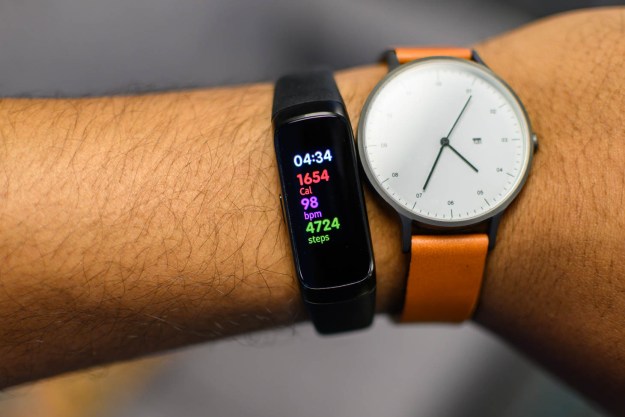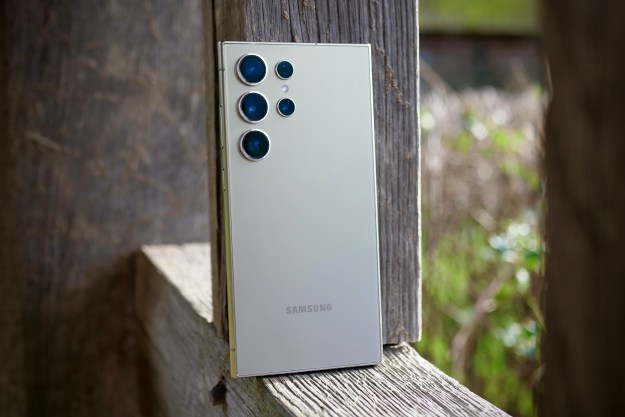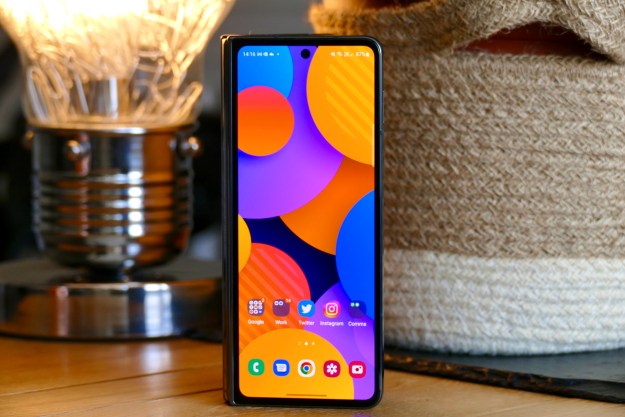
“For the casual athlete, the Galaxy Fit is the perfect fitness tracker.”
- Colorful and sharp AMOLED screen
- Plentiful workout plans, sleep tracking, accurate heart rate monitor
- 5ATM water resistance
- Comfortable and lightweight, interchangeable straps
- Affordable
- Notifications are cramped on the screen
- No onboard GPS
- Can't control music playback, no onboard storage
Editor’s note: Months after release, the Samsung Galaxy Fit remains our favorite fitness tracker for Android. However, the similarly priced Fitbit Charge 3 is our favorite overall, and is definitely worth a look.
It doesn’t cost an arm and a leg to get a good, basic fitness tracker these days, and while Fitbit’s latest lineup is looking strong, Samsung is putting up a fight for your attention. Its latest, the Galaxy Fit, goes toe-to-toe with the Fitbit Inspire HR — both cost $99 — but Samsung’s tracker narrowly edges out a win. Here’s why.
Slim profile, colorful display
What stands out is the 0.95-inch screen that’s protected by Gorilla Glass. Sure, it’s not as big as the 1.04-inch display on the Inspire HR, but it’s AMOLED, so not only are you getting deep blacks, but there’s plenty of vivid color. AMOLED makes the screen on the Galaxy Fit more visually interesting, and the use of color helps me quickly distinguish certain data sets when I’m working out.
The Fit may not have the brightest screen, but it’s good enough to read text outdoors in direct sunlight. Text is also sharp, thanks to the 120 x 240 resolution.
There isn’t a huge selection of watch faces, but the ones available are stylish. But that’s not the word I’d use to describe the wearable itself; it looks like an average fitness tracker. There’s a silver case model, but I like the all-black Galaxy Fit, which is more subtle. The Inspire HR definitely wins points for better design, even if it is a bit bulkier.
I do like the Galaxy Fit’s low profile, meaning it easily hides under a shirt cuff, and it’s so lightweight that you’ll forget it’s on your wrist. The included silicone strap is comfortable and doesn’t feel cheap, nor does it attract too much dirt. It’s interchangeable too, and Samsung sells other strap options so you can customize the look.
Interface and notifications
There’s only a single button on the Galaxy Fit, so most of your interactions will be performed via the tracker’s touchscreen. The button acts as a back button, so it will take you to the previous screen. You can also press and hold it to start your favorite workout, which can be set through the Galaxy Wearable app.

The touchscreen is responsive; I never had any issues scrolling through the widgets and notifications. I do wish you could tap on the screen to have it light up, instead of needing to press the button, but this is a minor gripe. If you raise your wrist, the screen will automatically light up, and this function works well.
The left side of the watch face is where all your notifications are, and the right side has all the widgets. You can easily add and arrange widgets via the companion app, and you can manage the apps that send notifications to the tracker, so you won’t get bombarded.
It’s nice to be reminded to move, as it genuinely helps keep me aware of how much time I spend sitting.
I like seeing notifications on the Galaxy Fit, but since the screen is so small, text is difficult to read. I largely used the feature to look at the app the notification is from, and used that information to decide whether I wanted to reach for my phone to check it. You can tap on the notification to read the contents (this will require a bunch of swiping), and you can reply with preset responses. The haptic vibrations from notifications are strong enough to make you notice, but not overpowering.
There’s a broader variety of apps you can respond to with the Galaxy Fit, which gives it a leg up over the Inspire HR. The preset responses can be customized through the app, but there’s no direct way to reply through a keyboard or through voice typing. For that, you’ll need to upgrade to a smartwatch like the Samsung Galaxy Watch or Galaxy Watch Active.
A swipe down from the watch face will bring you to quick-settings tiles, where you can toggle on Do Not Disturb, tweak the screen’s brightness, and more.
Fitness tracking
The highlight is all the fitness features the Galaxy Fit packs. It can automatically detect six workouts, including running and cycling, but there are more than 90 different workouts you can track via the Samsung Health app.
My two favorite features are inactivity reminders and when the Fit automatically detects and starts tracking my walks after 10 minutes. It’s nice to be reminded to move, as it genuinely helps keep me aware of how much time I spend sitting at a desk. And when I’m walking, the tracker will automatically show me data like my distance, speed, and time elapsed after 10 minutes. It further encourages me to keep walking so I can potentially hit my step goal.
What about tracking workouts? The Galaxy Fit automatically detected when I started a run, and logged the data, meaning one less step for me to manually start it. I strapped on an Apple Watch Series 4 to my wrist next to the Fit, and both devices delivered very similar results. Step count was a little lower on the Apple Watch, but only by 200 or so steps. Distance traveled was similar, as was heart rate during the workout. Resting heart rate was comparable between both devices in general.
You can also set the heart rate monitor to always track your heart rate — this allows for the fitness tracker to send a notification when it detects your heart rate is unusually high while resting. But to conserve battery, you’ll want to use the “Frequent” option, which only checks for heart rate every 10 minutes when you’re not active.
The Fit’s sleep-tracking results were nearly perfect.
You can track your stress levels, but every time I feel stressed, the tracker tells me I’m not. The breathing exercises do help calm me down, though, which also helps bring down my heart rate.
What’s missing? Onboard GPS. The Inspire HR doesn’t have it either. That means if you want to map your runs, you’ll need your smartphone near you. The same applies if you want to listen to music, as there’s no internal storage available. You’ll just need to stream via your phone. What’s disappointing is there are no music controls, so even if you are streaming from your phone, you need to pull it out to switch tracks or change the volume — the Galaxy Fit can’t do this for you.
Sleep tracking
If you don’t mind wearing a wearable to bed, the Galaxy Fit can automatically track your sleep. I like looking at my sleep data, and I didn’t find the Fit uncomfortable, though I did loosen it a bit. The results were close to perfect. It said I was asleep for 5 hours and 56 minutes, which was only off by a few minutes.
This can vary night by night, and if you tend to read in bed or just lie down and talk with a significant other, the Fit can sometimes confuse this with sleeping. I generally found the results to be accurate, and if it is wrong, a notification from your phone in the morning allows you to confirm or correct the data.
Open up the Samsung Health app, and you can see the data broken down into how much of it was deep sleep, REM, or light. You can also rate your sleep to further enrich the data. I do think there’s more room for Samsung to offer guidance on what this data means.
Battery life and water resistance
The Galaxy Fit has a 120mAh battery that Samsung claims will last for a week. That may be the case if you only strap the Fit to your wrist and don’t use it for anything but basic tracking, and if you limit the heart rate monitor. I found the Fit typically lasts around three days — that’s with a short workout sprinkled in every day, frequent heart rate and sleep tracking, and checking of notifications. The third day of sleep tracking wasn’t possible for me, as I had to plug the tracker into its charging cradle.
If you’re a swimmer, you’re in luck. The Galaxy Fit supports swim tracking and offers 5ATM water resistance, so you can take it into the pool. Pro tip: There’s a handy water lock setting you can turn on if you want to wear your Galaxy Fit in the shower — it prevents the screen from activating when water hits it.
Price, availability, and warranty information
The Samsung Galaxy Fit costs $99 and is now available from Samsung’s website and select retailers.
Samsung offers a standard limited warranty that covers the product from manufacturer defects — and not much else — one year from the date of purchase.
Our Take
The Samsung Galaxy Fit is a no-frills fitness tracker perfect for casual athletes. The notification system makes you want to keep wearing it after a workout, and the excellent sleep tracking makes you want to wear it to bed.
Is there a better alternative?
The Fitbit Inspire HR is the best alternative to the Galaxy Fit, but I prefer Samsung’s interface and full-color AMOLED display. Fitbit has a larger community, though, so it will be easier to find someone to exercise with and challenge through the mobile app if that’s what you’re looking for (you can also do this on the Galaxy Fit). Both have almost the same feature sets otherwise.
Spend a little more and you can get even more powerful trackers like the excellent Fitbit Charge 3, which lasts a full week. If you’re more interested in a smartwatch, then check out the Apple Watch Series 4 if you have an iPhone, or Samsung’s Galaxy Watch Active if you have an Android phone. You can read more in our guide to the best fitness trackers.
How long will it last?
The Galaxy Fit should last you more than two years. The battery may start to give way then, which will mean it’ll be time for an upgrade. Otherwise, its build is quite durable, and water resistance ensures it can survive the elements.
Should you buy it?
Yes. If you’re a casual athlete looking for a basic but powerful fitness tracker, Samsung’s Galaxy Fit should be at the top of your list.
Editors' Recommendations
- Samsung just launched a $400 phone in the U.S., and it looks great
- YouTuber MKBHD says this new gadget is the worst he’s ever reviewed
- Best smartwatch deals: Samsung, Google, Apple, Fitbit, and Garmin
- A surprise phone just beat the Galaxy S24 Ultra in a big way
- Samsung’s Galaxy AI is about to get a lot more useful




